How to Write a Marketing Resume That Will Help Land Your Dream Job
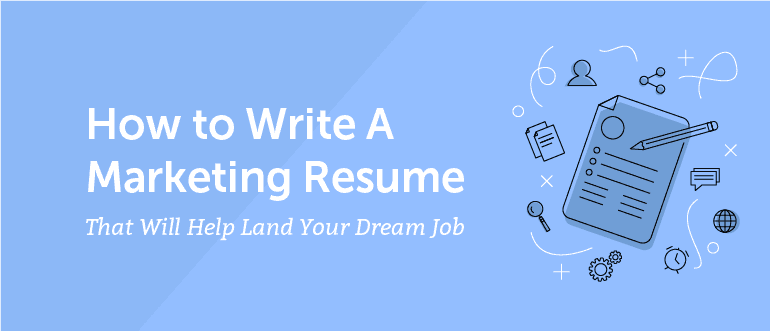 Writing a marketing resume isn’t easy. If you consider yourself a writer by trade, that sentiment might feel ironic. But, it’s true. Summarizing your history and skills in one page is tough, especially when your future career prospects hang in the balance.
No pressure or anything, though.
Fortunately, it’s a skill you can develop.
This post is geared toward the following folks:
Writing a marketing resume isn’t easy. If you consider yourself a writer by trade, that sentiment might feel ironic. But, it’s true. Summarizing your history and skills in one page is tough, especially when your future career prospects hang in the balance.
No pressure or anything, though.
Fortunately, it’s a skill you can develop.
This post is geared toward the following folks:
- College students and recent graduates looking for internships and entry-level jobs.
- Experienced marketers applying for their next opportunity.
- Marketing managers and HR professionals researching what to look for when hiring various marketing roles.
How to Write a Marketing Resume That Will Help Land Your Dream Job by @Ben_CoSchedule via @CoSchedule
Click To Tweet- A Story ...
- Free Marketing Resume Template
- Are Resumes Still Important?
- What Makes Getting Yours Noticed So Difficult?
- What Does An Effective Resume Look Like?
- Planning Your Resume
- Formatting Your Resume
- Writing Your Resume
- Writing a Content Strategy Resume
- Writing a Social Media Marketing Resume
- Writing a Marketing Manager Resume
- Writing a Copywriting Resume
- Writing a Product Marketing Resume
- Writing a Public Relations Specialist Resume
- Writing an SEO Specialist Resume
- Writing a Marketing Project Manager Resume
- Writing a Paid Search/Social Resume
- Consider Creative Resume Formats
But First, A Story …
When I was in college, I was worried I wouldn’t find an internship, nor a full-time job following that. The economy was down and prospects were slim, so getting a foot in the door didn’t look particularly easy. I had also never written a resume before, and given the circumstances, I knew mine needed to be good. Fortunately, I did have some relevant experience built up from working at the student newspaper, tutoring, and various freelance gigs. After doing extensive research online, I did my best to put one together would convince a hiring manager I deserved an opportunity. In order to make sure my efforts were up to par, I made an appointment at the university career center for a resume review. I thought they’d tear it apart, tell me everything that needed fixing, and send me on my way, ready to spend more time polishing it up. Instead, something else happened. After reading through my cover letter and resume, the student advisor looked up and said, “This looks really good. In fact, we’re going to use this as an example for other students to follow. Nice work!” That wasn’t the response I expected, but I was glad to take it. This is a 100% true story, and I’m not sharing it to boast, either. Instead, I'm sharing this experience to show that getting the job you want in this industry is an attainable goal. And it all starts with your resume.Steal My Marketing Resume Template
Since then, I’ve used roughly the same template for every job I’ve applied for. It’s gotten me several internships, and all three of my full-time jobs in the industry (in ecommerce, at a mid-sized agency, and now at CoSchedule). There’s nothing fancy about it, but it’s clean, clear, and it works. I’ve also adjusted it slightly to better fit different needs and experience levels. Here’s everything the bundle includes (each one is included in both Microsoft Word and iWork Pages formats):- Marketing Internship Resume Template
- Entry-Level Marketing Resume Template (Less Than 2 Years Experience)
- General Marketing Resume Template (2+ Years Experience)
- Marketing Manager Resume Template (8+ Years Experience)
Job hunting for your next marketing opportunity? Snag these free #marketing resume templates:
Click To TweetAre Resumes Still Important?
In a word, yes. While LinkedIn is a vital tool for demonstrating your skills and expertise, hiring managers still typically want to see a resume. It’s a big part of making a good first impression, so it’s important to get yours right.What Makes Getting Your Resume Noticed So Difficult?
Hiring managers often have too many to look at. Most of the time, it really is that simple. According to Time, that’s why the average resume only gets looked at for six seconds. In order to stand out, you have to make yours look exceptional.Avoiding Resume Mistakes
There is nothing worse than sinking hours into the perfect job application, only to have your efforts undone by unforced errors, like typos (this is especially important for marketers and writing-based roles). From not catching spelling errors to failing to tailor your resume to the role you’re applying for, Thomas Frank does an excellent job of summarizing what not to do in this video:What Does an Effective Resume Look Like?
It’s easier to replicate success when you have an example to follow. This template is closely based on one I created myself in college, and have used for the past decade. It’s clean and simple, but it has worked well in my experience: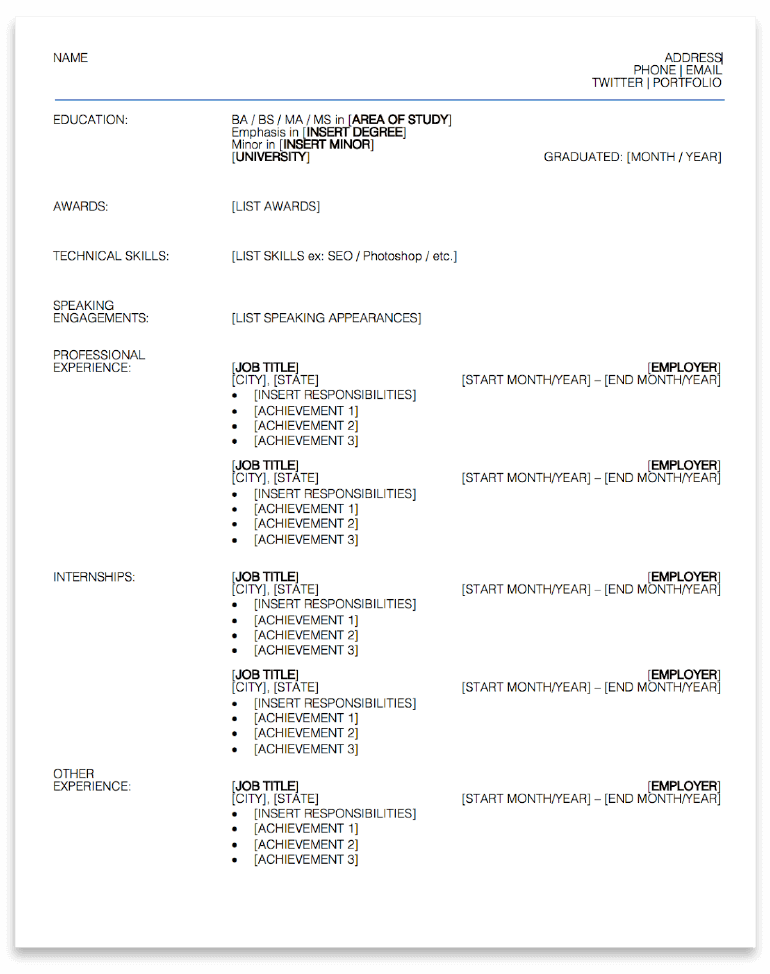
Here's how to write and format an effective #marketing resume
Click To TweetPlanning Your Resume
Before you start writing, it’s a good idea to prepare all the information you’ll need. You’ll need to round up previous work-related experience, contact references, summarize your strengths, and more.Know Who Will Be Reading Your Resume
Every resume you send should be tailored toward the job you’re applying for. Generally, it’s a good idea to create one generic resume that you can adjust depending on the company or role you’re targeting. This doesn’t have to be rocket science. Start with these tips:- Read the company’s website. This will give you an idea what they’re like.
- Research the company. What can you find out about them from news articles, blogs, or other third-party sources?
- Give their front desk a call or send an email. When it comes time to write a cover letter, it helps to address it to the right person. Find out who that is by making a quick inquiry (if that information isn’t easily available on a job listing).
Assess Your Strengths
Know what sets you apart as a candidate. Everyone is unique and possesses individual talents. Understanding them can help guide your career by emphasizing what you’re best at. If you haven’t before, it’s worth taking the StrengthsFinder self-assessment test. It’s a book that comes with a code you can use to login to a web-based survey that will help you better understand your strong points. This short video summarizes how it works: Having strengths in things like learning, ideation, and strategy are extremely useful for creating educational marketing content. Makes sense, right? I just wish I would have taken it sooner.
Having strengths in things like learning, ideation, and strategy are extremely useful for creating educational marketing content. Makes sense, right? I just wish I would have taken it sooner.
Round Up References and Employment History
If you’re new in your career, this may be a challenge if you don’t have much experience to lean on. When you submit a resume, include references on a separate sheet. Include the following information for each person:- Name
- Company
- Job Title
- Phone Number
- Email Address

Location. Location. Location.
This step matters most if you’re applying for a job in another state or city, and will need to relocate. There are varying schools of thought on this, but this post will argue it’s best to be honest. Consider the following:- If the job is within a commutable distance, use your own address.
- If you’d need to travel a longer distance for an interview, state that in your cover letter.
- If you can, consider using a friend or relative’s address in the city.
Formatting Your Resume
So, what should this thing look like? It’s an important question, and there are a handful of minor tweaks you can implement to improve formatting.Step 1. Pay Attention to Font Choices
There are two types of fonts to pay attention to here: serif and sans-serif. The graphic below illustrates the differences between the two: Source: Source: https://www.quora.com/What-is-the-difference-between-serif-and-sans-serif-typefaces
There are key differences between serif and sans-serif fonts, and how they affect readability:
Source: Source: https://www.quora.com/What-is-the-difference-between-serif-and-sans-serif-typefaces
There are key differences between serif and sans-serif fonts, and how they affect readability:
- According to Harshita Arora, sans-serif fonts offer a slight boost in readability. That’s why I used a sans-serif font on mine.
- Too many fonts is considered a negative for readability. Again, mine only uses one font (just in different formatting and sizing here and there).
Step 2: Consider Narrower Margins for Wider Sentence Length
Resumes need to include a lot of information in very little space (ideally, within one page). One way to squeeze in more detail about yourself while retaining a clean look is to use narrow margins. This helps you fit more text per line. If you’re using Microsoft Word, you can easily set wider margins by clicking on the Layout tab: Next, click Margins. Then, select Narrow:
Next, click Margins. Then, select Narrow:
 This is how the template included in this post sets its margins.
This is how the template included in this post sets its margins.
Step 4: Use Bold Text Selectively
Bolded text can help important elements of your resume stand out. Consider bolding items such as:- Your college and major/minor.
- Previous companies and job titles.
Writing Your Resume
You’re finally ready to start doing some actual writing. Here’s how to make sure you nail it.Step 1: Put Your Contact Information at the Top
A hiring manager will need to know the best way to contact you, and where to find more information about yourself and qualifications. Make their job easier by including each of these items:- Name: Include your full name.
- Street Address: See the previous tip on location.
- Email Address: Use something that sounds professional. yourname@gmail.com looks better than party_guy_2000@yahoo.com or something else embarrassing.
- Twitter Bio: This is considered essential for a good number of marketing jobs. Only share it here if you tweet about topics relevant to marketing, or the company’s industry where you’re applying.
- Portfolio: If you have an online portfolio, add a link here. You can also replace this with a blog or personal website URL, if it’s relevant to marketing.
#Marketing #resume tip: include your contact information (along with your Twitter handle and portfolio tip) at the top.
Click To TweetStep 2: Next, Include Your Education History
In most cases, this will mean your college or university. Only list your high school if you didn’t attend college (no judgment here--I know people who have done well in digital marketing without attending or going into post-secondary education). Include the following:- The type of degree you received: This means a Bachelor of Arts (BA) or Bachelor of Science (BS), Master of Arts (MA) or Master of Science (MS, or an Associates (AA).
- Your major and minor: This may be formatted differently depending on the details of your degree programs. For example, my degree was in Mass Communications, with an Emphasis in Print Journalism and Public Relations.
- Next, list your college: Also include the month and year you graduated (or plan to graduate).
Step 3: List Professional Awards
If you’re active in your community, or have a little bit of work-related experience, you may have been recognized for your efforts. Some examples might include:- Academic honors for high-performing marketing students.
- Awards from professional or student organizations.
- Business and civic associations.
Step 4: Include Previous Speaking Engagements
If you get the opportunity to speak at an industry event, take advantage of it. It’s a great way to share your knowledge, and you often learn more about your topic by trying to explain it to others. They also show a willingness to volunteer your time to help others, and indicate a high level of competency in the field. Don’t have anything to put here? No worries. Just consider this tip something to think about.Have you spoken at an industry event? Include details on your resume.
Click To TweetStep 5: Lay Out Your Most Relevant Technical Skills
Once the general “about yourself” content is completed, it’s time to get down to your capabilities. If you’ve gone through college, have some work experience, or have a relevant side hustle, then you have some skills. However, it’s important to prioritize the ones that are most relevant to the job you’re applying for, and the ones where you’re most proficient. Here are some examples of skills you might need:- Writing.
- Research.
- Proficiency with Word, Excel, and PowerPoint.
- SEO.
- Data analysis.
- Branding.
- Campaign strategy.
- HTML/CSS.
- Adobe CC (Photoshop, Illustrator, etc.)
 Source
Now, what if you’re making a career change and don’t have what you think is relevant experience? In that case, it’s time to get creative, and determine how your existing skill set might transfer. Here are some examples:
Source
Now, what if you’re making a career change and don’t have what you think is relevant experience? In that case, it’s time to get creative, and determine how your existing skill set might transfer. Here are some examples:
- Are you a skilled researcher?
- Has your past work experience required a heavy amount of writing or design?
- Do you know how to analyze data and extract meaningful insights from it?
- Is project management and organized teams an area of strength for you?
Step 6: List Your Professional Experience
Here, start with your most recent relevant job position. Then, work your way backward chronologically. If you have too many to list, or if you’re applying for a senior role where you have lots of experience (say, maybe 10 years or more), then consider adding a second page to your resume. Otherwise, choose other areas to trim down, or include just your top three or four jobs. Be sure to include:- Company.
- Job Title.
- Employment Dates.
- Make it clear how your work positively impacted the business.
- Use statistics. “Increased traffic by 75% and conversions by 8%” sounds better than “Increased traffic and conversions.”
- Illustrate times where you’ve shown initiative. Maybe there was a problem you solved, or a major win you scored for the company without being asked.
Writing a resume for a marketing job? Mention not only your previous responsibilities, but what you actually accomplished.
Click To TweetStep 7: Do the Same For Past Internships or College Work Experience
If you’ve had internships in the past, repeat the process above. For those in college or recently graduated applying for internships, include previous internships or relevant campus jobs if you’ve had them. If you’re applying for your first internship or job, and you’re struggling to muster enough experience to round out your resume, consider the following tips:- Think about all your past jobs and whether you gained any transferable skills.
- If you’ve done any pro bono work, consider listing it like an employer.
- Any relevant coursework where you produced actual portfolio pieces might also be worth including in a pinch. Lean toward sharing on-the-job experiences, though.
Step 8: Include Volunteer or Pro-Bono Work
Finally, add any volunteer experiences you might have. Start with those that are relevant to the job or industry. Then, if you have others (and have extra space to fill), include those too. Showing that you’re engaged in your community and giving with your time can add a small boost to your resume.Three General Resume Writing Tips
Stick to One Page (Or Two, if You Must)
Unless your employment history is extensive, stick to one page. Two may be acceptable if you absolutely need extra length, but keep in mind that hiring managers are often busy people. One easily skimmable page will make their life easier.Be Honest
It’s easy to fudge the truth, thinking you won’t get caught. Don’t do it. If your actual skills don’t live up to your description on paper, your new employer will absolutely notice.Prioritize Your Most Relevant Employment History
Generally speaking, there’s no need to include past jobs that aren’t relevant to marketing. There are a couple of exceptions, though:- You don’t have much professional experience (yet).
- You’re switching careers and this will be your first marketing job.
Resume Needs for 9 Different Marketing Roles
Marketing is a broad term that encompasses many different disciplines and types of jobs. In order to make this advice applicable to your own situation, find the role you’re applying for, and adjust according to the needs of the position.Writing a Content Strategist Resume
This role is high in demand across the industry. CNN Money predicts 19% growth for this role by 2024,What Does a Content Strategist Do?
Here is a brief job description from MediaBistro:“Day-to-day responsibilities often include creating and managing social media campaigns; monitoring engagement and analyzing data; managing content marketing campaigns; implementing SEO best practices; and building strategic partnerships.”
What Skills Does a Content Strategist Need?
The work of a content strategist can cover a lot of bases. Check out this diagram from Express Writers: So, what exactly do all those bubbles encapsulate?
So, what exactly do all those bubbles encapsulate?
- Editorial calendar management.
- Strong creative ideation skills.
- Experience with deep research. This is especially true if you’re not a subject matter expert in your company’s industry.
- A working knowledge of search engine optimization.
- Crisp and clear writing ability.
Example of a Content Strategist Resume
Here’s an anonymous example from LiveCareer.com (based on an example from an actual content strategist--this example is fairly nondescript, but note the skills listed):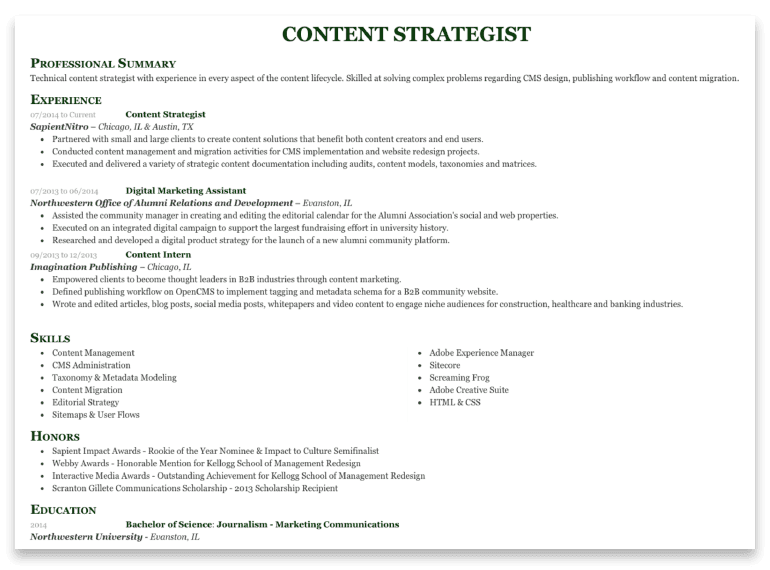
Writing a Social Media Marketing Resume
Managing social media means more than just sharing GIFs all day.What Do Social Media Specialists Do?
Here’s a look at a day in the life of a social media manager from Buffer: According to Jeff Bullas, here are 10 skills a good social media manager should have:
According to Jeff Bullas, here are 10 skills a good social media manager should have:
- Strategic planning.
- Expertise around tactical execution.
- Community management.
- Understanding how content travels across the social web.
- Content optimization.
- Creativity.
- Writing skills.
- Knowledge of digital marketing trends.
- Data analysis.
- Leadership and communication.
Example of a Social Media Strategist Resume
This example below from Lauren Marinigh, a freelance social media and content marketing specialist, checks all the boxes: It puts experience first, then continues onto a second page:
It puts experience first, then continues onto a second page:
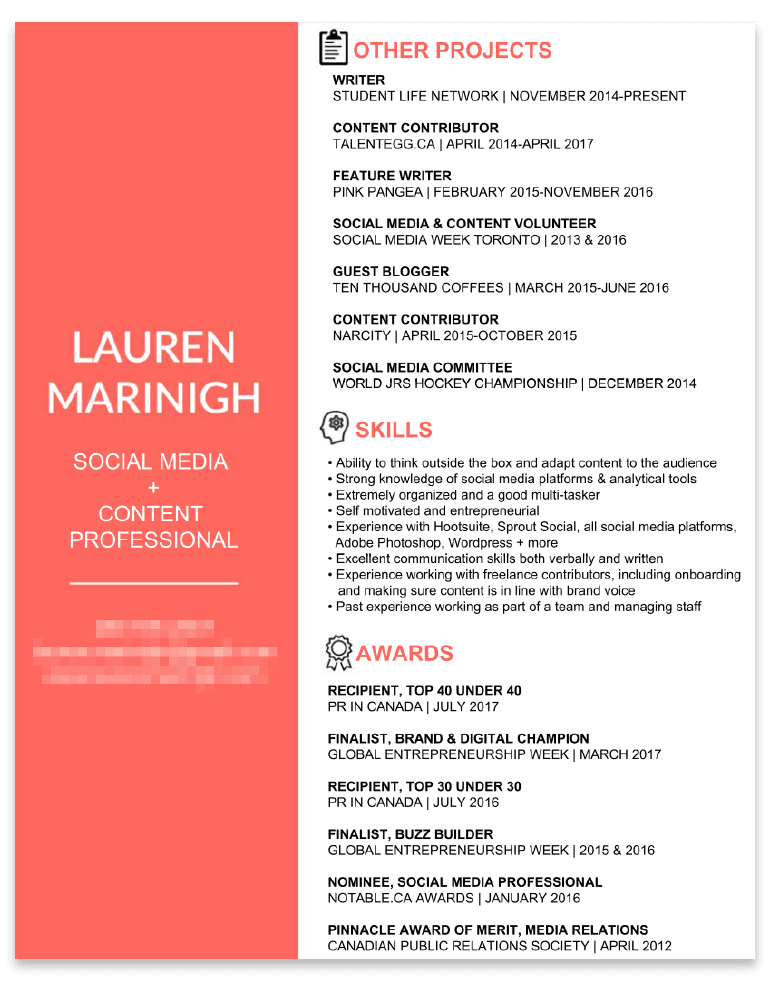
Writing a Marketing Manager Resume
What Does a Marketing Manager Do?
At this level, the required skill set moves away from focusing on execution, and starts to include project and personnel management. Take a look at this job listing template for a senior marketing management role from Glassdoor: Next, take a look at common responsibilities for marketers at this level:
Next, take a look at common responsibilities for marketers at this level:
 This is based on aggregate research Glassdoor (a company that has access to tens of thousands of job descriptions). If you’re looking to make the leap into management, there are some skills here you’ll likely need to acquire:
This is based on aggregate research Glassdoor (a company that has access to tens of thousands of job descriptions). If you’re looking to make the leap into management, there are some skills here you’ll likely need to acquire:
- Having a strong grasp on project management.
- Understand how to use complex CRM software.
- Be able to guide both the strategy and execution of all marketing activities.
Marketing Manager Resume Example
Speaking of Nathan, here’s a look at the actual resume he used to get his job at CoSchedule back in 2014:
Writing a Copywriting Resume
If you’re both a conceptual thinker and skilled wordsmith with a passion for selling, then copywriting could be the path for you.What Does a Copywriter Do?
Copywriting jobs come with a diverse range of needs. You might be writing short-form content for social media posts day, headlines for print ads the next, and website copy the following week.Copywriter Resume Example
If you’re applying for traditional agency copywriter position, getting creative with formatting may not be a bad idea. In fact, I know someone who scored an agency job with a resume he wrote on an old-school typewriter, demonstrating the kind of outside-the-box thinking the job requires while keeping the focus on his capabilities for wordcraft. Here’s an example of a well-designed copywriting resume:
Writing a Product Marketing Resume
Do you get excited about copywriting, seeing how products get developed, and helping to bring them to market? You might find this role to be a great fit.What Does a Product Marketer Do?
Product marketers are responsible for shaping how products are perceived by the public. In this role, you’ll need to know how to connect customer problems to product-based solutions in a way that’s creative and compelling. Strong copywriting and project management skills are essential. Here are four basic skills you’ll need according to Digital Marketing Institute:- Writing: Copywriting capabilities are core to success in this role.
- Presentation Skills: You’ll need to present complex ideas to stakeholders.
- General Marketing Skills: The basics will take you a long way.
- Basic Business Knowledge: Since you’re marketing products directly, it’s important to understand how the whole business operates, as well as being involved in the product development process.
 They continue with seven more soft skills that are beneficial:
They continue with seven more soft skills that are beneficial:
- Love to solve problems: Explaining what makes a given product the best solution in a compelling way is core to this role.
- Get comfortable with not having all the information you need: Sometimes, solutions to those problems won’t be clear. Part of the job is being able to figure things out anyway.
- Prioritize! You’ll always have too much to do, so know how to focus on what’s most important first.
- Strategic Thinking: This job requires being able to think ten steps ahead at all times.
- Collaboration: In this role, marketers work with all different types of teams, including product designers, developers, project managers, and more.
- Decision-making: Product marketers ultimately have to make a lot of calls on messaging and marketing. Know how to be decisive and fail fast.
- Creativity: Connecting the dots between customer problems and product-based solutions takes flexible thinking and ingenuity.
Product Marketing Resume Example
Here’s an example from GetSetResumes (note that in this example, the applicant came from a deep background of business and product development before moving over to marketing):
Writing a Public Relations Specialist Resume
If you’re outgoing and focused on details, then you might have a bright future in PR.What Does a PR Specialist Do?
Anything and everything to build relationships and foster a positive perception of a company or organization. This typically means:- Securing press coverage.
- Hosting and promoting events.
- Managing a presence at conferences.
- Community management and social media.
- Communication skills.
- Research skills.
- Writing ability.
- International language skills (if you’ll be working for a large, global brand).
- Creativity.

PR Specialist Resume Example
In this industry, a straight-forward resume is typically best. Check out this example from LiveCareer.com: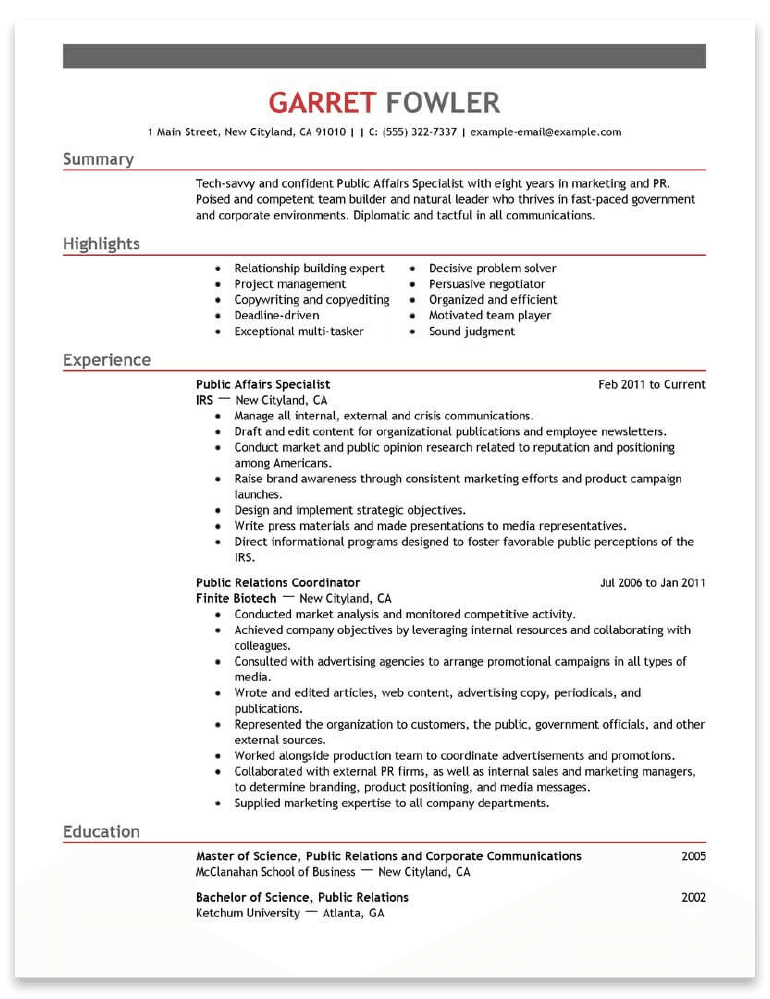
Writing an SEO Specialist Resume
How does content rank on Google? That’s what search engine optimization specialists figure out.What Does an SEO Specialist Do?
If you had to break it down into one sentence, SEO is all about getting content to rank, drive traffic, and convert. But, there are lots of different types of SEO roles out there:- On-site SEO: Get comfortable knowing what terms like “title tag,” “keyword research,” and “H1” mean.
- Off-site SEO: Links from other sites, as well as mentions on reputable sites, have immense impact on ranking performance. Off-site SEOs (or link builders) work to earn those links, often in conjunction with PR and outreach specialists.
- Technical SEO: These folks require deep understanding of web development, and deal with structural and coding best practices for organic search.
SEO Resume Example
A quick search for a search marketer’s portfolio should turn up results if they’re good at their job, right? That’s how I found this example from Kern Media: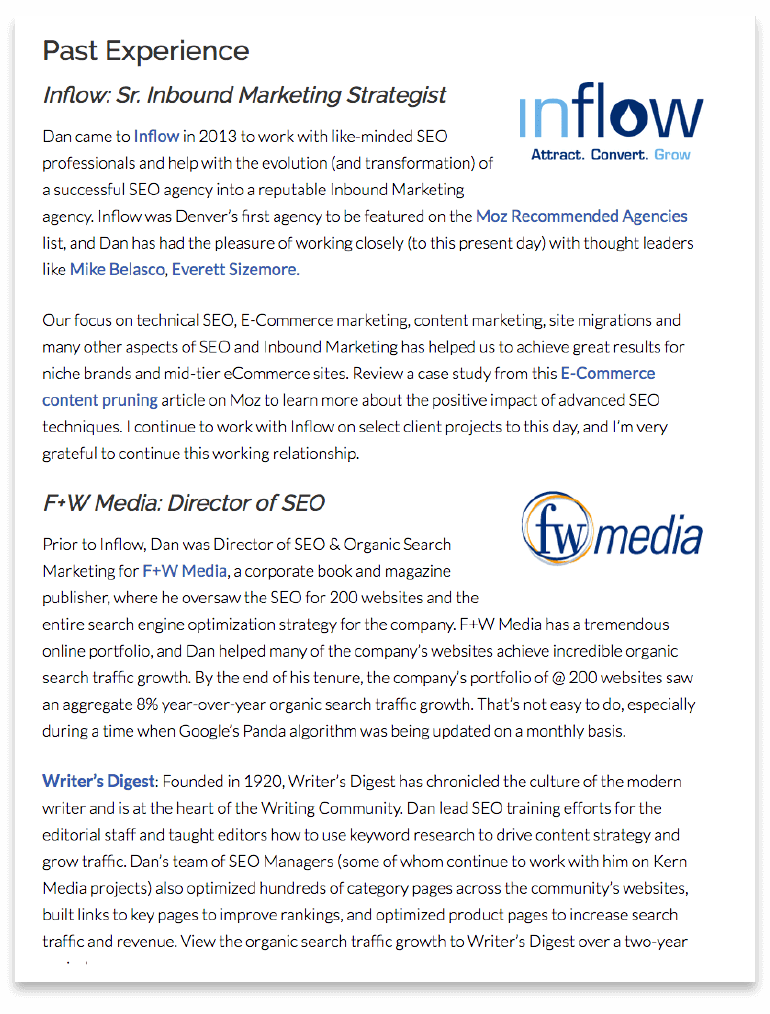
Writing a Marketing Project Manager Resume
Who herds cats on marketing teams? Project managers. If turning chaos into cohesion is your thing, this might be the role for you.What Does a Marketing Project Manager Do?
Project managers ensure marketing projects and campaigns are executed effectively and efficiently from start to finish. They ensure that timelines are enforced and that everyone on the team has what they need to succeed. When roadblocks crop up, they also work on finding solutions to keep the team moving.Marketing Project Manager Resume Example
 Source: http://www.lauracannon.com/resume.html
It continues onto a second page with detailed work history:
Source: http://www.lauracannon.com/resume.html
It continues onto a second page with detailed work history:
 Source: http://www.lauracannon.com/resume.html
Source: http://www.lauracannon.com/resume.html
Writing a Paid Search/Social Resume
While content marketers, content strategists, SEOs, and PR pros focus primarily on organic inbound strategies, specialists in PPC (pay-per-click) and paid social media work to attract audiences and customers with paid tactics.Paid Search Resume Example
This resume stands out for its visual design, while highlighting the skills required to do the job well: https://www.slideshare.net/AManjunatharao/my-resume-ppc-analyst-manjunatharao-a?qid=1c23b2ce-c306-4ab1-bc12-52ec734de54d&v=&b=&from_search=1Consider Creative Resume Formats
So far, this post has looked primarily at examples of traditional resumes. However, there are a handful of other formats in the examples above too, like using SlideShare presentations, or creative design. In most cases, for most marketing jobs, a clean and simple resume will suffice. What’s important is that it’s easy to read, and your work experience is impressive. However, it’s a crowded job market out there. While I personally have stuck with simple one-page black-and-white resumes, others have had success thinking outside the box (and I’m not one to argue with success). It’s easy to fall into a trap of trying to be too flashy. But, if you’re applying for a creative role (like an ad agency copywriter or social video specialist), then going above and beyond might help you stand out. Here are some ideas and examples that have worked for others.Video Resume
Videos can be a great way to help hiring managers get a sense of who you are before bringing you in for an interview. I have no idea if this guy was successful, nor if humor is necessarily the best angle for everyone, but this video resume example is both A) creative and B) well-produced:SlideShare Resume
Marketers often create slide presentations. Lots of slide presentations. Often, their purpose is to sell clients or team members on the merits of a campaign or idea. Or, you’ll need to present data and reports to show results and prove you’re worth paying. So, why not apply those skills toward selling yourself to an employer? If you can do that successfully, then certainly you could succeed on the job, too. Here’s another example of a great marketer’s resume on SlideShare: Note that this isn’t necessarily fancy or flashy, but it does provide its creator with another place to be found. If you’d like some help creating something like this, here are some good starting places:Website Resume
Here are some resources for building simple online portfolios (where you could also host a resume): And tutorials:Now Go Get Your Dream Job
If this post has succeeded, then the mystery around effective resume writing should be cleared up. Here’s a recap of what you’ve learned:- Everything you need to know about formatting and which information to include.
- What to do if you have little work history (or more than you can fit onto one page).
- How to highlight strengths, put your best foot forward, and get the job you’re after.


